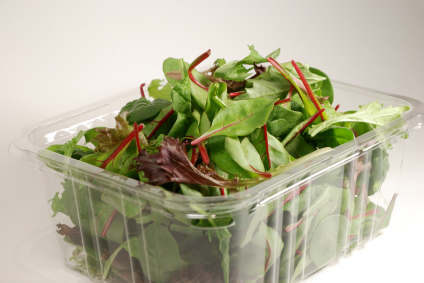Modified Atmosphere Packaging for Fresh Fruits and Vegetables

Unlike most food products, fresh fruits and vegetables continue to ‘breathe’ or respire after they have been harvested. This process consumes oxygen and produces carbon dioxide and water vapour. The key to keeping these packaged products fresh for as long as possible is to reduce the respiration rate without harming the quality of the product – its taste, texture and appearance. In general, the rate of respiration can be reduced by keeping the temperature low, having lower levels of oxygen in the packaging atmosphere and increased levels of carbon dioxide. However, things are not straightforward. For example if there is too little oxygen in the packaging atmosphere, a process called anaerobic respiration will kick in. This produces unwanted tastes and odours in the product and will cause the food to deteriorate. Furthermore, excessively high carbon dioxide can damage some varieties of product.
As well as these considerations, the high water content of this class of food, plus the fact that fruit are intrinsically acidic, can lead to spoilage from yeasts and mould. Also, the flesh can become soft because of attack by enzymes from microbes, eventually resulting in rotting.
The packaging material used for fruit and vegetables is especially crucial and in particular how permeable or breathable the material is. If the products are sealed in an airtight package, oxygen will soon become depleted and undesirable anaerobic conditions could develop. On the other hand if the material is too porous, the modified atmosphere will escape and no benefit will be derived.

The aim is to achieve a state known as equilibrium to produce a so-called equilibrium modified atmosphere, or EMA. Here, oxygen and carbon dioxide can pass between the inside and outside of the package in such a way that as oxygen is consumed within the pack it is replaced by oxygen from outside, and similarly a constant level of carbon dioxide is maintained. Another advantage of a modified atmosphere is that it reduces the natural production by the fruit or vegetable of a gas called ethylene, which speeds up the ripening process.
For a packet of mixed salad, for example, a typical EMA might consist of 5 per cent oxygen, 15 per cent carbon dioxide and 80 per cent nitrogen. This could increase the shelf life of the product to as long as eight days, whereas under air it would be lucky to remain fresh for four or five days.
A modified atmosphere can also have a dramatic effect on the browning of cut fruit and vegetables such as potatoes and apples, which is a result of an oxidation reaction brought about by enzymes that are released when the flesh is damaged. In these cases, having a mixture of carbon dioxide and nitrogen in the packaging, with no oxygen, can prevent browning for several days, as opposed to just a few minutes or hours in air.
On this page we are proud to present a guide to fruit and vegetable packaging made by the Danish Technological Institute:
Link to Guide - Packaging Fresh Fruit and Vegetables - PDF file
As well as these considerations, the high water content of this class of food, plus the fact that fruit are intrinsically acidic, can lead to spoilage from yeasts and mould. Also, the flesh can become soft because of attack by enzymes from microbes, eventually resulting in rotting.
The packaging material used for fruit and vegetables is especially crucial and in particular how permeable or breathable the material is. If the products are sealed in an airtight package, oxygen will soon become depleted and undesirable anaerobic conditions could develop. On the other hand if the material is too porous, the modified atmosphere will escape and no benefit will be derived.
The aim is to achieve a state known as equilibrium to produce a so-called equilibrium modified atmosphere, or EMA. Here, oxygen and carbon dioxide can pass between the inside and outside of the package in such a way that as oxygen is consumed within the pack it is replaced by oxygen from outside, and similarly a constant level of carbon dioxide is maintained. Another advantage of a modified atmosphere is that it reduces the natural production by the fruit or vegetable of a gas called ethylene, which speeds up the ripening process.
For a packet of mixed salad, for example, a typical EMA might consist of 5 per cent oxygen, 15 per cent carbon dioxide and 80 per cent nitrogen. This could increase the shelf life of the product to as long as eight days, whereas under air it would be lucky to remain fresh for four or five days.
A modified atmosphere can also have a dramatic effect on the browning of cut fruit and vegetables such as potatoes and apples, which is a result of an oxidation reaction brought about by enzymes that are released when the flesh is damaged. In these cases, having a mixture of carbon dioxide and nitrogen in the packaging, with no oxygen, can prevent browning for several days, as opposed to just a few minutes or hours in air.
On this page we are proud to present a guide to fruit and vegetable packaging made by the Danish Technological Institute:
Link to Guide - Packaging Fresh Fruit and Vegetables - PDF file




